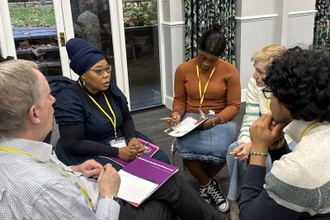Exhibition on the last Catholic Archbishop of Canterbury

Cardinal Pole by follower of Sebastiano del Piombo. Lambeth Palace. Image courtesy of Church Commissioners.
A fascinating little exhibition at Lambeth Place profiles Cardinal Reginald Pole, the last Roman Catholic Archbishop of Canterbury, Plantagenet cousin of Henry VIII whose Oxford and Italian education was sponsored by the monarch, despite having a stronger claim to the throne than him.
Pole was nearly elected Pope - losing by one vote. The course of European history and English Catholicism would have been very different if the moderate, humanist Pole had become Pontiff. At the opening of the Council of Trent he advised against rejecting ideas out of hand that Luther embraced as being false.
History has not always been kind in reflecting on his life. In his lifetime he was regarded with suspicion in Rome as a closet Lutheran, in Germany a Papist and in England as a traitor by the Tudors, excepting Queen Mary, whose overzealous rooting out of heretics marred Pole's reputation. He believed they should be treated with paternal love and allowed to rejoin the Catholic Church.
Addressing the English Parliament as Papal Legate in 1554 he said: "I come to reconcile not to condemn, I come not to compel but to call again."
The accompanying book, inspiration of Miles Young, Warden of New College offers fresh perspectives on the enlightened Cardinal. Aged 14, Young was fascinated by the charismatic cardinal as the source of a history project. He is the force behind the exhibits from New College's library, which holds much of Pole's own collection bequeathed to the College after his death.
The College collaborated with The Venerable English College, Rome, and Lambeth Palace library in producing this unique display of rare, printed books and classical Greek manuscripts once owned by the enigmatic Englishman. The lavishly illustrated, informative book, edited by New College Fellow, James Willoughby, highlights aspects of Pole's life in ten chapters offering varied sympathetic academic viewpoints.
Initially sympathetic to Henry's "great matter" of divorce he was shocked by the executions of the Carthusians, who had educated him as a boy at Sheen, fellow humanist Thomas More, and Bishop John Fisher. He wrote De Unitate, a vigorous defence of the unity of the Catholic church urging Henry to repent. An outraged king duly ordered the brutal execution of his mother, the Countess of Salisbury, daughter of the Duke of Clarence, brother to Edward IV and Richard III. He closely identified with Thomas a Becket and was buried close to the site of Becket's shrine in Canterbury Cathedral.
Pole developed a theology of justification as combining both faith and good works.
An absorbing chapter by Ann Dillon examines Pole's pivotal association with the 'Spirituali' movement and his relationship with aristocratic poet Vittoria Colonna and Renaissance giant Michelangelo. The 'Spirituali' focused on studying the Scriptures, prayer, and concepts of justification and consolation. Michelangelo's Vatican Pauline frescoes illustrated Pole's theological texts. Dillon suggests that both influenced each other.
A fine portrait belonging to Lambeth Place is displayed attributed to a follower of Sebastiano del Piombo. However, one wonders whether it could be by the master himself, considering his close association with Michelangelo, who was part of Pole's inner circle.
At the book launch and exhibition opening earlier this month, canapes were provided with figs from a tree planted by Pole himself 450 years ago near the main entrance courtyard of the Palace. They are particularly sweet and juicy. The 'White Marseille' fig tree producing chartreuse green fruit which is white inside when ripe, was brought to Lambeth when Cardinal Pole was appointed the last Catholic Archbishop of Canterbury in 1556. In June 2014, Archbishop Justin Welby presented Pope Francis with a cutting.
Amongst those present at the launch were Bishop John Sherrington, Auxiliary in Westminster who commented that he had learnt a lot from the exhibition. The Rector of the English College, Rome, Stephen Wang was enthusiastic about collaborating with Lambeth Palace and New College in highlighting Pole's life and legacy. University of Cambridge Emeritus Professor of Divinity, Eamonn Duffy pronounced it "wonderful". Pole became Chancellor of both the University of Cambridge and Oxford.
Pole's untimely death from influenza the same day as Queen Mary on 17 November 1558 was the end of English Catholic hopes.
His theological vision of the church as communal not hierarchical was ultimately fulfilled in the Second Vatican Council. He, like Thomas More, saw the primacy of conscience as pivotal and embraced in English law. Ultimately his foundations of the seminary system for training of priests came to fruition.
Reformation Cardinal: Reginald Pole in Sixteenth-century Italy and England
Until 15 December, 9.30am to 5pm Monday to Friday.
Saturday 4 November and 2 December 10am - 5pm.
Lambeth Library Exhibition Room
Admission free
Digital exploration see : https.www.lambethpalacelibrary.info/reformation-cardinal/reformation-cardinal-digital-exhibitions/
Book published by New College Library and Archives 2023
Edited by James Willoughby
ISBN 978-1-9160651-3-0
UK Price £16
See: https.www.new.ox.ac.uk/reformation-cardinal-book


















